You have to pick and choose what dog training advice, tips and “style” to use for your own dog. Don’t listen to me or anyone else.
With my own dogs (a senior Lab mix and a young weimaraner), I tend to gently guide them to do what I want, praise them and give firm corrections occasionally when they don’t do what’s expected. Update: RIP, Ace.
My focus is on structured exercise, calm and positive leadership, consistency and clear rules so they know what’s expected.
We have never allowed Remy the weim on the couch, for example. Not once, not even as a tiny puppy. Because of this, hopping on the couch is simply not on his radar. Clear, consistent rules make a big difference.
Still, Remy is a big challenge for me, constantly seeing what he can get away with.
My two dogs are very different, and I’m not training or raising Remy in the exact same way I raised my senior dog Ace.
So I wanted to share some of the common training tips – ideas I would normally use and recommend – that I threw out the window when I got my weimaraner puppy Remy.
Let me know if you can relate to any of this! Which tips do you normally use or ignore? And has your dog challenged you to train differently than you’re used to?
Dog training advice I threw out the window when I got my weimaraner
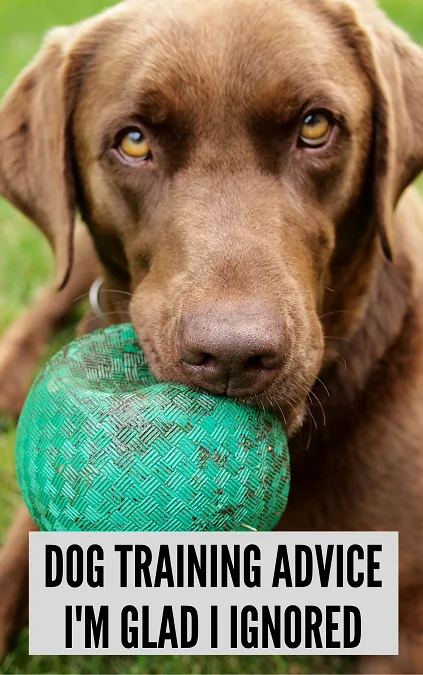
1. Make your dog work for his food. Feed him as a reward.
Great advice. I say this all the time. It’s actually something nearly all dog trainers would agree on!
However, my weimaraner is so food obsessed that in the morning he’s drooling and shaking and moaning in his kennel for his food.
Frankly, it’s just easier to feed him immediately and get that stress behind us.
Yep, I feed The Prince and then we go for a walk.
For the longest time, I fought this and made Remy “work” for his food by walking him and then feeding him.
This just ended in frustration for both of us.
All Remy could think about on our walk was getting back home to eat. Our walks were not fun. He pulled like a train. He could not focus on me or on anything. I lost my temper every morning, and it was not a good way to start the day.
So, I feed the freaking dog immediately.
Our walks are much more relaxing this way.
You do what works.
2020 update: Remy is 4 years old now, and I am now able to feed him AFTER our walks. This works for us now. It did not work in the past.
2. Cradle your puppy until he stops squirming.
When I first got my puppy, people told me it was important to “cradle” him on his back and only let him go when he’s calm and stops squirming.
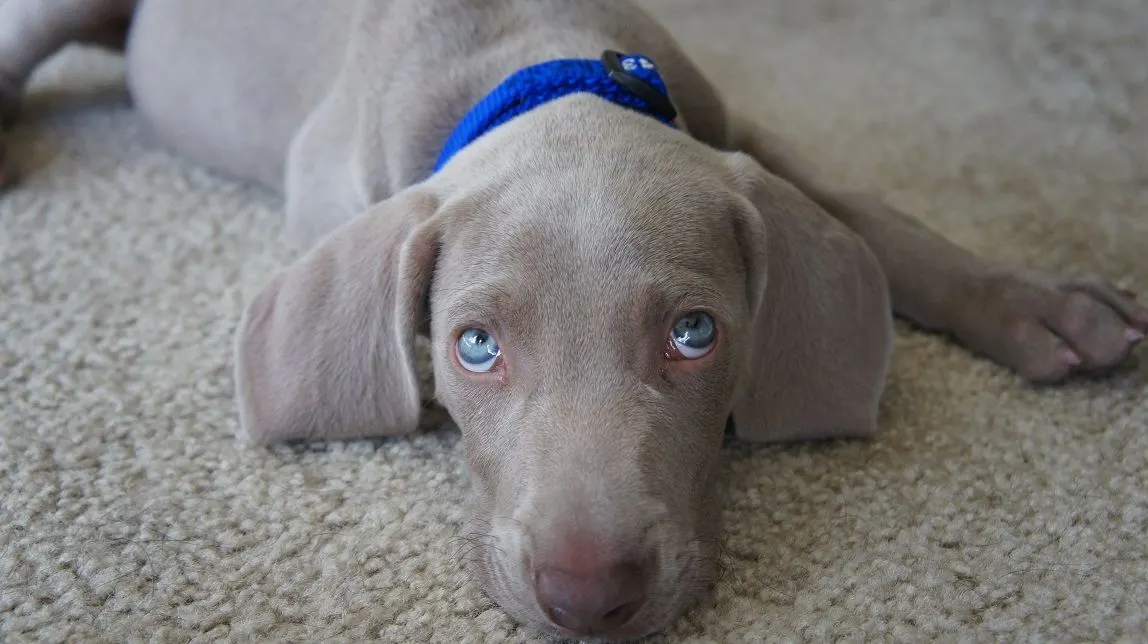
This is especially important with a powerful breed like a weimaraner, they said. Not necessarily to be “alpha” but to encourage the valuable skill for a puppy to accept being restrained and to feel comfortable and relaxed being held.
I think this advice is generally great!
However … this DID NOT work for Remy!
Even at 8 weeks, he would absolutely not “surrender” to being cradled. He would squirm and kick and bite and as time went on he would become more and more aggressive.
I held him for 45 minutes one time, trying to sooth him and calm him while remaining as relaxed as I possibly could.
He was mad with energy! It was more of a wrestling match than a bonding experience. I was determined not to let go until he calmed down.
Well, let’s just say he never calmed down. I had scratches and bite marks on my arms and legs and stomach.
He and I are both stubborn. Apparently him more than me.
So I stopped doing this ridiculous exercise.
3. Positive reinforcement training is best. Science tells us so.
Yes. By all means, stick with positive reinforcement as much as you can.
This means reinforcing the behavior you like by rewarding your dog with food, toys or access to whatever he enjoys. Research says this is the best way for a dog to learn a behavior.
I use a lot of positive reinforcement with Remy, but not 100%.
My dog is very … “willful” and frankly, sometimes I just need to be a Mother Bear and give him a firm “NO.”
I have to say, I’ve even bopped him on the nose a few times for nipping me or jumping on me. It’s not something I’m comfortable recommending, but you know what? It gets the point across.
My dog is very resilient. He’s strong, fearless, wild and just plain rude at times. My older dog Ace snarls at Remy to communicate, “STOP. NOW.” My cats smack Remy in the face to politely as possible tell him to “Seriously, Fuck Off.”
Sometimes when I see my dog is about to jump on me, I step forward and hip-check him. I encourage others to stick out their knee.
Yes, positive reinforcement works and we should all use it, but maybe not every second of the day for every dog.
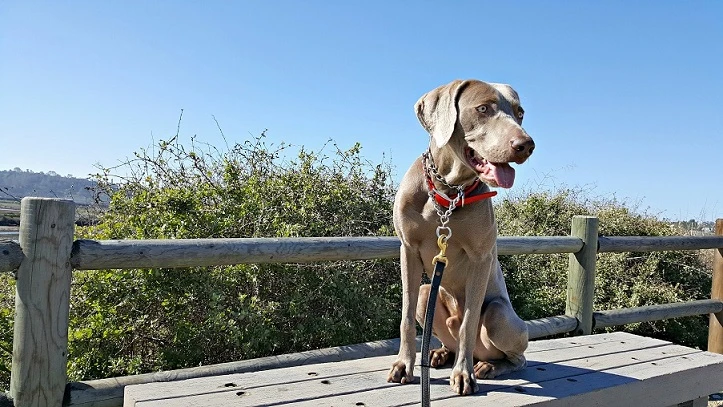
4. Don’t use a choke or prong collar. They’re outdated.
I highly recommend a Gentle Leader for walking (fits over the dog’s muzzle) or a no-pull harness that clips in the front. I have both and use them as much as possible. These limit the pulling for most dogs (even Remy!) and are less likely to cause injuries compared to any collar around a dog’s neck.
However, I also use a chain collar for walking Remy about 50% of the time, depending on the situation. (This doesn’t mean YOU should. It’s just what works for us.)
I’d prefer to use a Gentle Leader, but Remy holds his breath, puts his head low and pulls like a train. He does not pant properly while wearing one and can too easily overheat. He also paws at it, which causes other dogs to react to us.
I’d also prefer to use a no-pull harness, and thankfully this works for us in most situations. It’s just not ideal in tight, congested areas with other dogs. This is because when he’s in a harness he tries to “hop” on his hind legs when we pass other dogs.
Obviously, this is not ideal in an urban setting. This makes other dogs too excited or nervous. It’s embarrassing, and it’s not responsible on my part.
A chain slip, martingale or prong collar allows me to take my dog just about anywhere and keep him calm and under control.
Remy can pass people without jumping on them. We can take him to breweries and coffee shops. I can take my dog out into the world to tire him out mentally and physically and keep on socializing and training him.
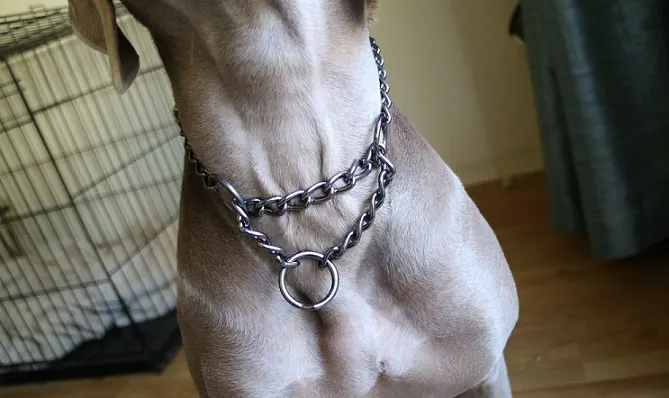
Yes, I’d love to transition to a regular martingale collar or the Gentle Leader. But for now, the chain collar it is.
See my post: Gentle Leader vs. prong collar
5. Use treats often for rewards.
Treats are a great training tool. I use them occasionally and absolutely recommend you use treats for your dog. I recommend Zukes minis. They’re currently 20% off at Chewy’s for their Cyber Monday Sale.
However, food tends to make Remy extra nutty. He’s generally better behaved, more focused and just all-around a nicer dog when we train with minimal treats and toys.
I keep some treats in my pocket, but he only gets them when he’s relaxed (not mouthing my hands, jumping, fixating or trembling with excitement).
An occasional treat is good.
Other than that, my dog has an easier time focusing and learning when I use calm, verbal praise like “gooooood booooy.”
I wrote about a specific example of this in our agility training here.
So … as you can see, general dog training advice is GOOD, but you really need to consider your individual dog and pick and choose what works for you.
Don’t worry what others tell you is “right.” It might be right for their dog, but not necessarily yours.
That goes for everything I say on this blog too.
Every dog is different.
Every environment is different.
Every owner is different.
And everything is always changing.
What dog training advice have you generally used or ignored?
Let us know in the comments! Please be kind to one another.
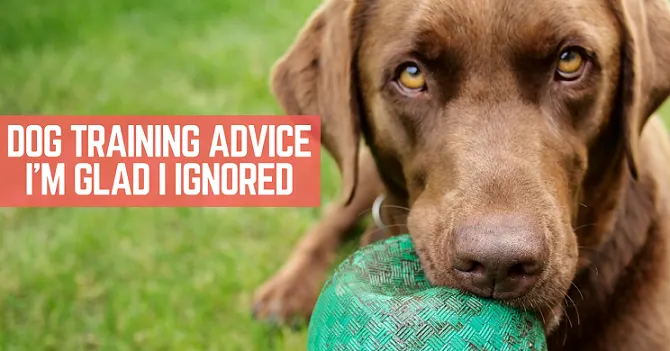

Mary Sue
Friday 27th of November 2020
I love your honesty and your humor...our male golden is a little over 2 1/2 years old and has always been very high-energy; he's also really smart...we love him & he's a sweet boy, but he's a teenager; so we started using a prong collar for walks once we completed his puppy training...and he does so much better with it. I felt 'guilty' at first, but not any longer. I can work with him on 'heel' for a few minutes off and on during our walks, and he walks with less pulling- more enjoyable for both of us.
Lindsay Stordahl
Friday 27th of November 2020
Oh yes, what a difference it makes!
Meg
Sunday 19th of July 2020
Great article! I agree that positive training doesn’t work 100% of the time. I have had to use the pet corrector on my Malinois a few times to get my point across especially when she was chasing cars! Every dog is different! My Mal had all kinds of “issues” at first but once I gave her a job ( we do Nosework and tracking) she calmed way down!
Peggy
Saturday 18th of July 2020
We had our 15 year old puppy girl put to sleep last month. We knew we'd get another dog, but we didn't think we'd have a puppy in less than a week. WHAT HAVE WE DONE? Bo is now ~3 months old and we've had him just over 4 weeks. Horrible on the leash (mutt, mini Australian Shepherd and Border Collie for sure) - jumps up, snarls, tries to bite, pulls on leash, repeat, repeat, repeat, repeat. Got him into puppy class week 3. Trainer said to step on leash, say "wrong, let go", and when Bo lets go to immediately grab the leash again. Bo was having tantrums and I was doing this for 10 minutes at a time, which was getting frustrating. Also just not working - only made him want the leash more. So I got on (where else?) Facebook yesterday afternoon after manic attack #2 with the leash and 2 more band aids on my leg - the Love Train page where our Humane Society gets a lot of puppies. Yesterday evening I took a small tote bag with a chew toy and treats plus. When Bo started to get even a little manic I squeaked the toy and pulled out a treat. Worked! Took him on short walks every hour or so today - maybe only around the back yard, maybe 2-3 houses away. He was mostly great until our 7:00 PM walk (which is during the witching hours so I sort of expected it). We were on our way back when he started jumping and grabbing at the leash. I held the leash and turned away from him. Didn't engage in a tug of war - just held the leash and looked away. Squeaked the toy again. He did it about 3 times and then just trotted on along. He gets constant "good boy", "good boy Bo" the whole time, too. Please let this continue to work!
c.k.
Monday 18th of November 2019
I knew a guy who could ONLY use a prong collar on his dog - a purebred Golden!
Now, my Lucy (mutt) could get out of ANY collar, so when I wanted to restrain her, I used a harness. She hated it, but never tried to escape it (that I know about).
Alena
Thursday 5th of September 2019
My weim puppy is SO much like Remy and is why this blog makes me feel so much better that I'm not alone in this Weim-teenage-puppy life. I have sought the training of MANY internet trainers and in person ones too. We ended up sticking with 2 trainers in our area. When my puppy goes to new places, he is very excited and wants to immerse himself in the environment, smell everything, and drag me along with him. One of the trainers saw this behavior and showed me a method of controlling him which involved stepping on his leash so tightly it forces him to lay down when he doesn't listen to commands I give to him when excited in a new place. She said to step on the leash clip right at the collar, which forced him to lay down and surrender. He did NOT like this at all and never surrendered. We actually tried this with a pinch collar once (which hurt my heart a little bit during this exercise - I'm usually a fan of prong collars used correctly) and finally then, he surrendered but was VERY upset and nervous about it. I have stopped practicing this exercise with him at home because it doesn't seem to help anything because it makes him very frustrated, anxious, and upset. When I tried it at home initially, he actually started to get VERY bitey with me and defiant. As soon as I told him to stay in a lay down, his pupils would dilate, he would jump up against the leash pressure then bite my commanding hand or my leg with some decent pressure as in a desperate plea for me to STOP. I'm all for tough training, since like you know, Lindsay, my puppy needs it and sometimes it's the only thing that he will respect. So instead of this forceful training, if he needs some restraint training, I will hook the handle of a leash to the inside of a closet door and close it, put his bed down next to it, tell him to lay down, and let him learn that if he calms and lays on his bed, he will get a reward. This way it still is teaching him some self control while not being forced to do something he REALLY doesn't want to do. Thanks for this blog!!
Lindsay Stordahl
Thursday 5th of September 2019
Oh Alena, I know what you mean! The pupils dilating and everything. That is Remy! It's a fine line because Remy needs tough love but when too tough he does get aggressive as you described with your pup. I know him really well now and how to manage him and when to push and when to be more light. It's all very situational with him. Always a challenge!